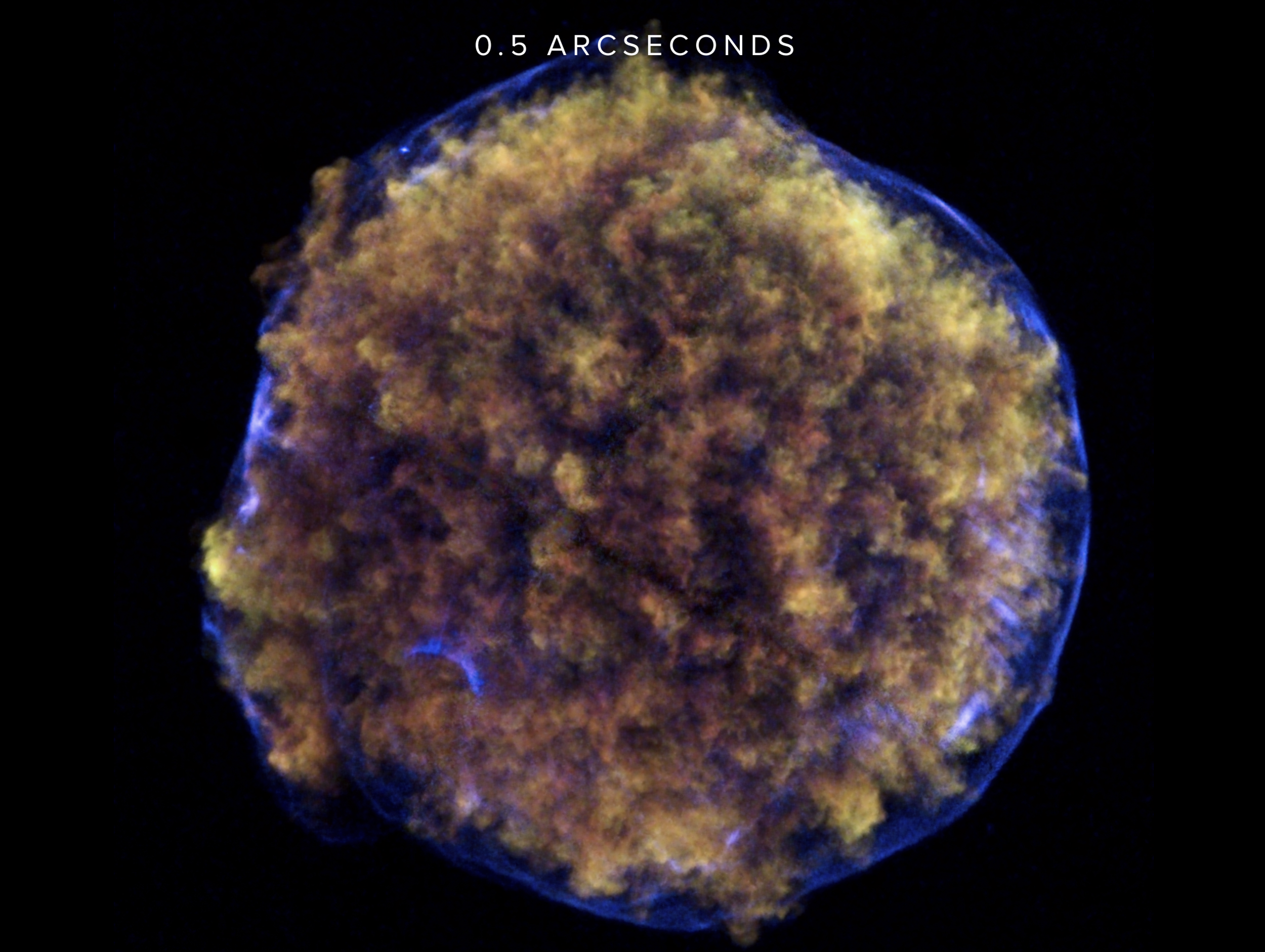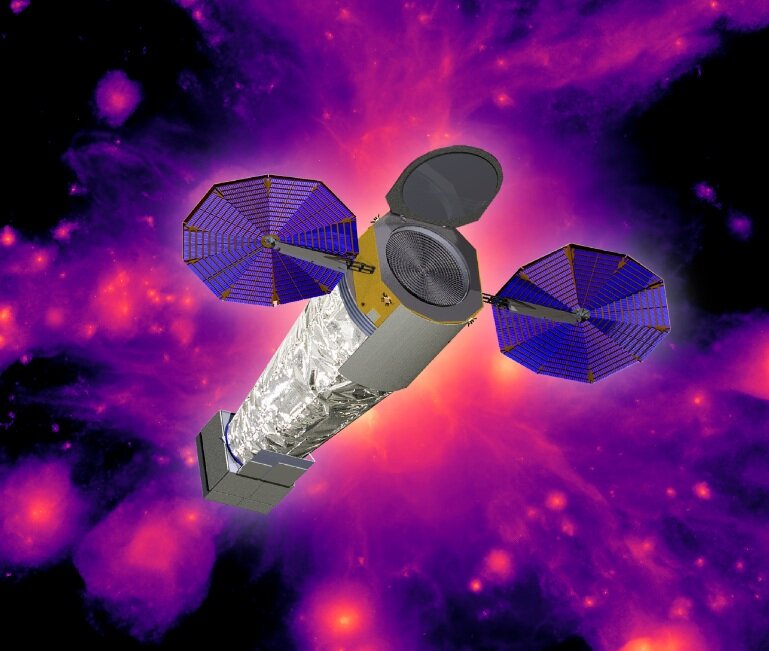Imagine comparing the 1936 Schmidt Telescope on Mt. Palomar (18'') to the most advanced telescopes in the world today. That is the leap between Chandra and Lynx.
Using Chandra's proven spacecraft design approach, Lynx will fly a revolutionary new mirror and instrumentation suite.
Eyes, Sharp as a Lynx
Lynx will provide fifty times the throughput of Chandra, while preserving its hyper-sharp spatial resolution.
Spatial resolution matters. A lot.
Sharp. Everywhere.
Chandra's point-spread-function (PSF) blooms off-axis, meaning that its exquisite spatial resolution is maintained only within the central 2.5 arcminutes of the image.
Lynx, with its new optics design, will maintain sub-arcsecond spatial resolution out to ten arcminutes, a sixteen-fold improvement over Chandra in area. Combined with a fifty-fold improvement in throughput, this will enable Lynx to survey the X-ray sky 800 times faster than Chandra.
Two weeks with Chandra?
A day's work for Lynx. Every Observation is Legacy Class.
This Chandra image of Kepler's Supernova Remnant consumed 8.7 days (~750 ksec) of observing time.
Lynx could create an even more stunning image, over a larger field of view, in a few hours.
The Lynx X-ray Mirror Assembly
Lynx optics are an assembly of densely packed, thin, grazing incidence mirrors. The outer diameter of this nested shell will be 3 meters, enabling a total effective area of 2 square meters at 1 keV. They represent a transformational advancement in X-ray optics relative to Chandra, and are at the heart of Lynx's grasp on the Universe.
a proven spacecraft
The most powerful X-ray optic ever conceived, with a revolutionary instrumentation suite at its focus. All of this will fly on a proven, relatively simple spacecraft that builds on immense heritage from Chandra. No complex deployment sequences. No sunshades. Provisioned with enough fuel for more than twenty years of operation without servicing.
Use your mouse and finger to move Lynx. Pinch or use the mouse wheel to zoom.
REVOLUTIONARY INSTRUMENTATION
the Lynx X-ray Microcalorimeter (LXM)
Long the dream of X-ray Astronomy, the X-ray Microcalorimeter can achieve unprecedented spectral resolution. Only Lynx couples the exquisite spectral resolution of a microcalorimeter to sub-arcsecond spatial resolution. This will enable collection of truly three dimensional data, realizing the full potential of this transformational technology.
The Hitomi SXS Microcalorimeter, consisting of a 6x6 array of 30" pixels (820 microns each) spanning a 3' field of view.
Dreams made real.
An X-ray Microcalorimeter is the only instrument that can hear the songs of supermassive black holes in distant clusters. Its exquisite spectral resolution enables the mapping of sound waves driven by black hole feedback at velocity resolutions approaching ~30 km/s.
Despite three heroic past attempts, and a remarkable (but tragically short) legacy left by Hitomi, a multi-year mission flying an X-ray microcalorimeter has been a dream long deferred.
The Lynx X-ray Microcalorimeter (LXM) will enable spatially resolved spectroscopy across a 5 x 5 square arcminute field of view, sampled with 1 arcsecond (50 micron) pixels, at an energy resolution of 3 eV. That's 90,000 pixels. Subarrays will be optimized for sub-arcsecond imaging and maximal spectral resolution (0.3 eV). In case you haven't guessed, yes: this is an extraordinary instrument.
A section of the technology prototype for the main LXM array. Here 50μm-sized (1") absorbers, 1280 total, are packaged into 4x5 "hydras", connected to 64 transition edge temperature sensors operating near T=0K.
Black holes play musical notes.
Lynx will listen.
Hitomi, the tragically short-lived JAXA mission, demonstrated the power of X-ray microcalorimeters with its historic Perseus Cluster observation.
Lynx will map the velocity structure of turbulence and sound waves driven by supermassive black holes at ~50 km/s resolution on sub-kiloparsec scales. Music to our ears.
the High Definition X-ray Imager (HDXI)
The High Definition X-ray Imager is Lynx's sharpest eye, melding the exquisite spatial resolution and PSF stability provided by the mirrors.
The HDXI is optimized for high-resolution imaging across wide survey areas. It will have moderate spectral resolution (100 eV) over 0.1-10 keV, and excellent image quality. Fine, 0.3 arcsecond pixels, will cover a 20 x 20 arcminute square field of view. The point spread function will remain highly stable even at large off-axis angles, as the detectors will tilt to follow the optical focal surface. This will enable Lynx to survey the X-ray sky 800 times faster than Chandra. It is the ultimate survey machine.
A hybrid CMOS prototype under development for the HDXI.
A simulated 400 square degree Lynx HDXI Survey showing groups and clusters of galaxies color-coded by their distance.
the X-ray Grating Spectrometer (XGS)
An even higher spectral resolution is required for absorption-line studies of diffuse baryons in galactic halos and in the cosmic web, physics of stellar coronae, and assessing the impact of stellar activity on habitability of their planets. This capability will be provided by the X-ray Grating Spectrometer (XGS). The XGS gratings arrays can be inserted into and removed out of the optical path. These arrays will cover 2/3 of the input aperture, providing 4,000 square cm of effective area at the astrophysically important X-ray lines in the 0.2–2 keV band. The dispersed spectrum will be read out with a dedicated array of Si-based sensors. The resolving power will be fairly uniform across the band, at R ≈ 5,000 and possibly higher.
the new great observatory
the Spacecraft
Revolutionary payload.
Proven spacecraft.
Lynx is built around a large area, sub-arcsecond grazing incidence X-ray mirror assembly and three revolutionary science instruments.
Together, they will enable high-sensitivity wide-field imaging at exquisite angular and spectral resolutions.
The Lynx team has a preliminary design of an end-to-end "Reference" mission concept, fully detailed here in our Interim Report.
the Mission
The Lynx capabilities are revolutionary but the observatory design is proven and simple. It goes to the L2 orbit, which easily reaches 90% observing efficiency in a stable environment. Not consumable constrained for 20 years. Pointing control, thermal systems, structures all use flight-proven Chandra design approach.
The Launch
No large sunshade. No unfolding telescope. The Lynx deployment sequence is simple and routine.
The entire payload is 7 tons and under 4.5 meters in diameter. It can launch on a heavy lift system that is available today, like Delta IV Heavy or Falcon Heavy.
A Beacon in the Void
One hundred days after launch, Lynx will be inserted into a halo orbit around the Second Sun-Earth Lagrange Point (L2), one million miles beyond the moon.
This orbit, with an 800,000 km semi-major axis, will maximize the time available for science observations, keep Lynx thermally stable, and negate the need for the spacecraft to traverse the Earth's Van Allen radiation belts, which render one-third of Chandra's orbit unusable for science.













